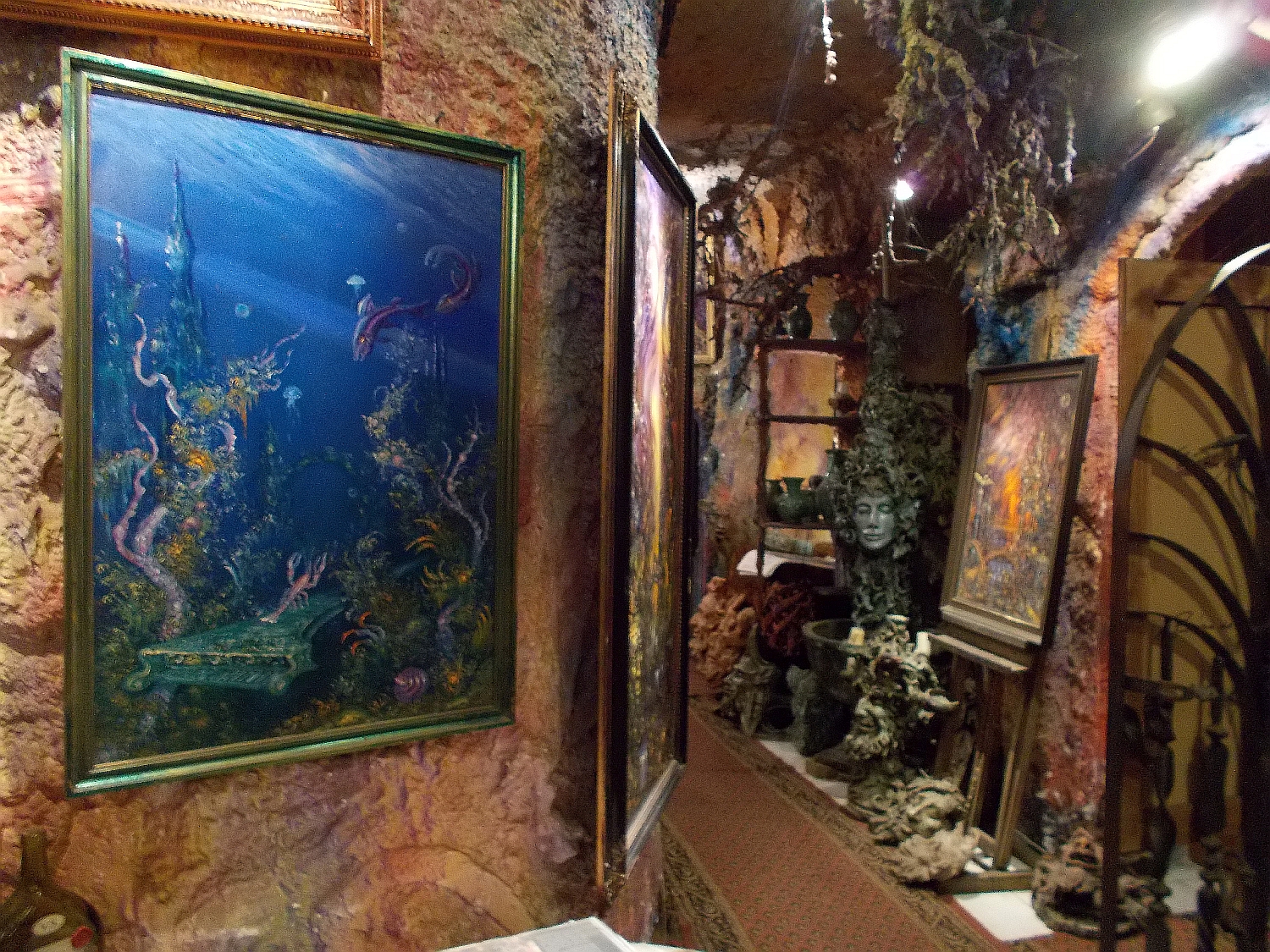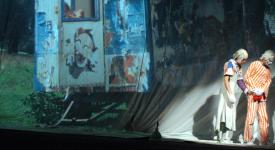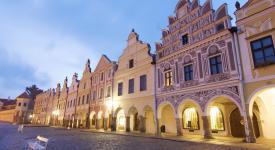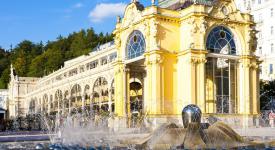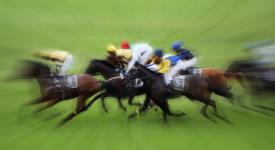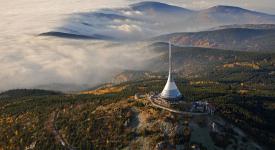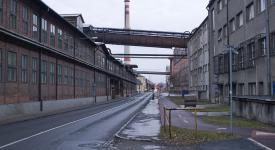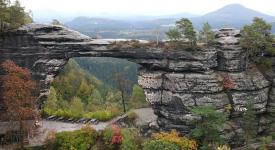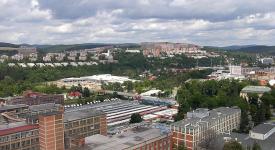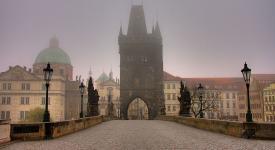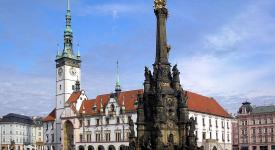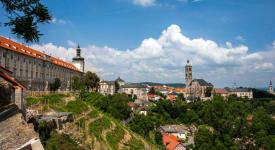Tschechien war vielleicht schon immer das Land der tausend Legenden und Sagen. Angefangen von Urvater Čech über Libuše und ihre Prophezeiung bis hin zu den Přemysliden sowie den Feen und Fabelwesen der tschechoslowakischen Märchenfilme, durchzieht Prag und das Umland ein Netz mystischer Geschichten. Gustav Meyrink, der unbestrittene Meister der Phantastischen Literatur, schrieb einmal: „Ich schlafe nicht und wache nicht, und im Halbtraum vermischt sich in meiner Seele Erlebtes mit Gelesenem und Gehörtem, wie Ströme von verschiedener Farbe und Klarheit zusammenfließen.“ So könnte auch die Beschreibung eines Bildes von Reon Argondian lauten, dessen Gemälde in leuchtenden Farben über mehrere Stockwerke hinweg in einem unscheinbaren Haus auf dem Prager Laurenziberg, der auf Tschechisch Petřín heißt, ausgestellt sind.
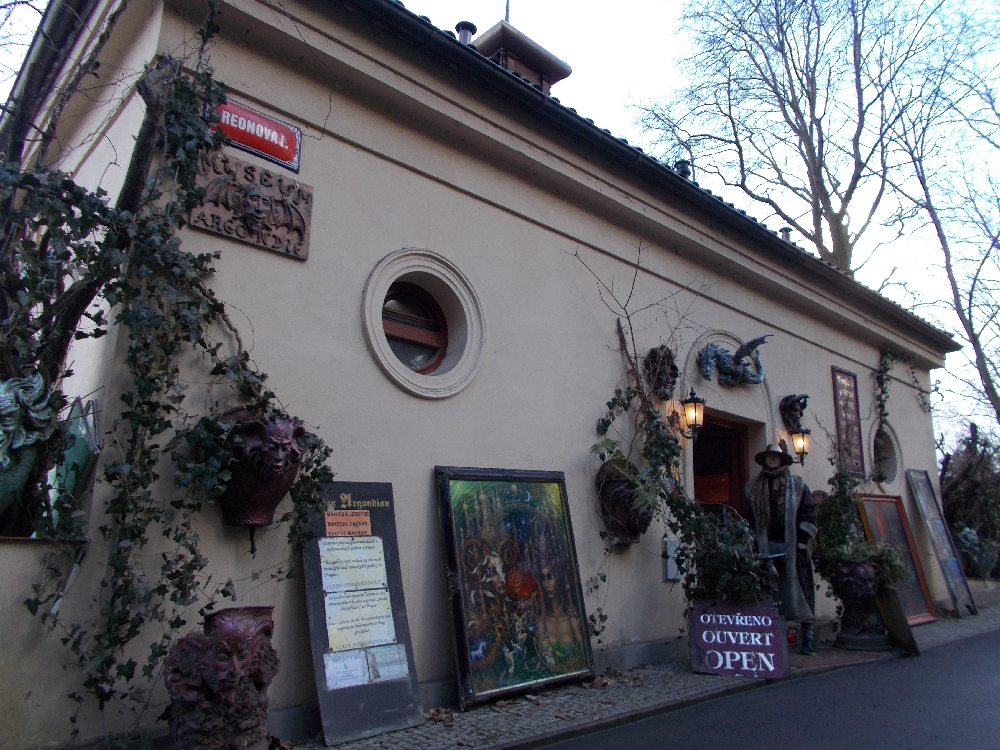
Foto: Konstantin Kountouroyanis
Reon Argondian, der am 21. Juli 1948 unter dem bürgerlichen Namen Jan Zahradník im Prager Stadtteil Vyšehrad geboren wurde, stand schon früh unter dem Einfluss seiner ebenfalls künstlerisch schaffenden Eltern. Sein Vater war Theaterregisseur. Zunächst machte er eine Keramik- und Töpferausbildung. Nach dem Prager Frühling verließ auch er das Land und folgte schon bald einer Einladung von Schweizer Freunden, um ebenda Kunstgeschichte zu studieren. Von der Schweiz aus ging er nach Frankreich, wo bald bewegte Jahre als Maler folgen sollten und wo er die phantasmagorische Welt als „Magische Höhle“ schuf. Hier entwickelte er u. a. auch die Bilder ausdrucksvoller, prophetischer Stärke, gleichsam Meyrinks Beschreibung seines Protagonisten Athanasius Pernath, der das Buch des Buddha Gotama gelesen hat: „Eine Krähe flog zu einem Stein hin, der wie ein Stück Fett aussah, und dachte: vielleicht ist hier etwas Wohlschmeckendes. Da nun die Krähe dort nichts Wohlschmeckendes fand, flog sie fort. Wie die Krähe, die sich dem Stein genähert, so verlassen wir – wir, die Versucher, – den Asketen Gotama, da wir den Gefallen an ihm verloren haben.“
Von der „Die Krähenmühle“ zum „Haus des Phönix“
1988 eröffnete Reon Argondian seine erste Galerie in Sainte-Brigitte, in der französischen Bretagne, mit dem trefflichen Namen „Die Krähenmühle“, die allerdings 1991 durch ein Feuer zerstört und schon 1992 durch „Das Haus des Phönix“ ersetzt wurde. Der Name des Hauses weist unverkennbar Parallelen zur griechischen Mythologie auf. Doch in seinem Heimatland hatte die „Sanfte Revolution“ von 1989 zwischenzeitlich vieles verändert, sodass er beschloss, wieder in Prag Fuß zu fassen. Mehr als ein viertel Jahrhundert, von 1969 bis 1995, hat Reon sich außerhalb seiner Heimatstadt und seines Landes aufgehalten. Seine erste Ausstellung im Karolinum - nach seiner Rückkehr - war ein voller Erfolg und so folgte kurze Zeit später sein Kunstprojekt der „Magischen Höhle“, das zunächst in einer alten Bäckerei unweit der Karlsbrücke aus der Taufe gehoben wurde. Doch der stete Wechsel zwischen zwei Galerien, die zudem auch noch über 1500 Kilometer voneinander entfernt waren, limitierten seine Schaffenskraft. Reon Argondian beschloss 1996, schweren Herzens, das „Haus des Phönix“ zu schließen und endgültig nach Prag zurückzukehren.
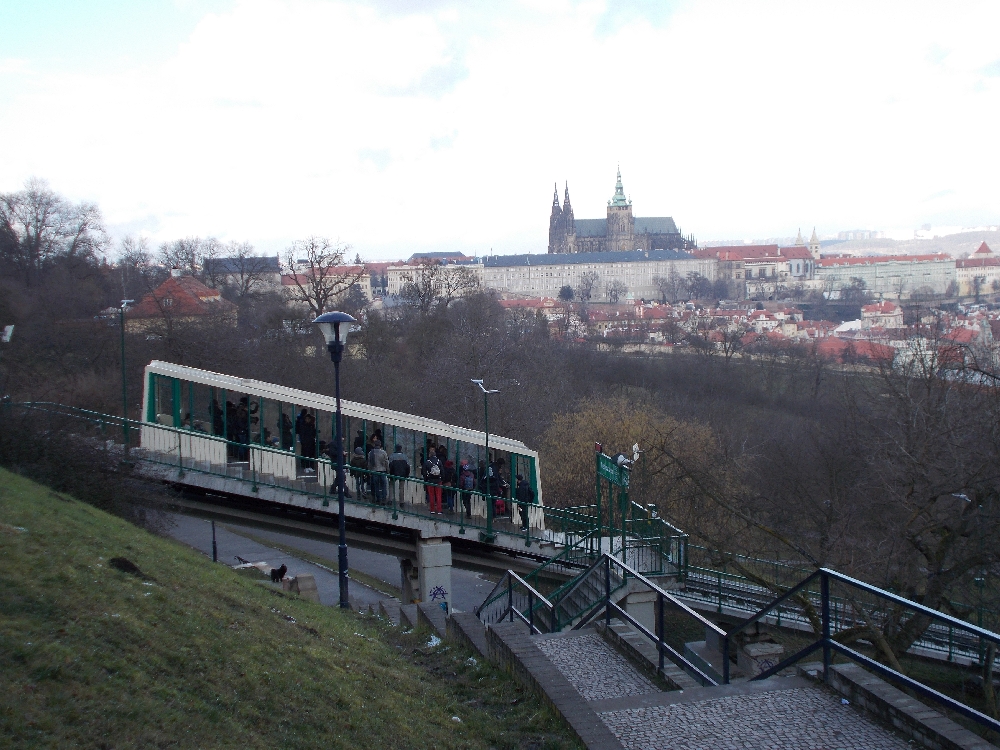
Foto: Konstantin Kountouroyanis
Haltestelle: Nebozízek
Ein Prager Original auf dem Petřín
Seit 2005 lebt und arbeitet er auf dem eingangs beschriebenen Laurenziberg in seinem Haus, das Atelier und Galerie zugleich ist. Wer heute an der Haltestelle Újezd der Standseilbahn (nicht Tram) einsteigt und an der ersten Zwischenstation „Nebozízek“ wieder aussteigt, findet ein Schild zur „Magischen Grotte“ bzw. „Magická Jeskyně“, das auf ein ca. 500 Meter entferntes Haus zwischen dem Waldrand und dem bekannten Parkrestaurant hinweist. Der Eintritt, der zwischen 20 – 70 Kronen (Kinder, Rentner, Erwachsene) beträgt und damit weit entfernt von den hohen Touristenpreisen in der Innenstadt ist, kann direkt am Eingang bei einem jungen Mann entrichtet werden, der dem Aussehen nach Reons Sohn sein könnte. Genau wie der Meister, steht auch der Kassierer in einem langen schweren Mantel und mit Schlapphut bekleidet vor dem Eingang, während Reons Erscheinung – wenn man Glück hat, kann man ihn dort selbst treffen – mit seinem langen Vollbart an den österreichischen und leicht exzentrischen Künstler Friedensreich Hundertwasser (auch als Stowasser bekannt) erinnert. Man kann Reon in einem Satz als einen Menschen beschreiben, der auf jeden Fall alles andere als an gesellschaftliche Konventionen angepasst und nur seinem eigenen Gewissen verpflichtet ist. Kurz: Ein Original!
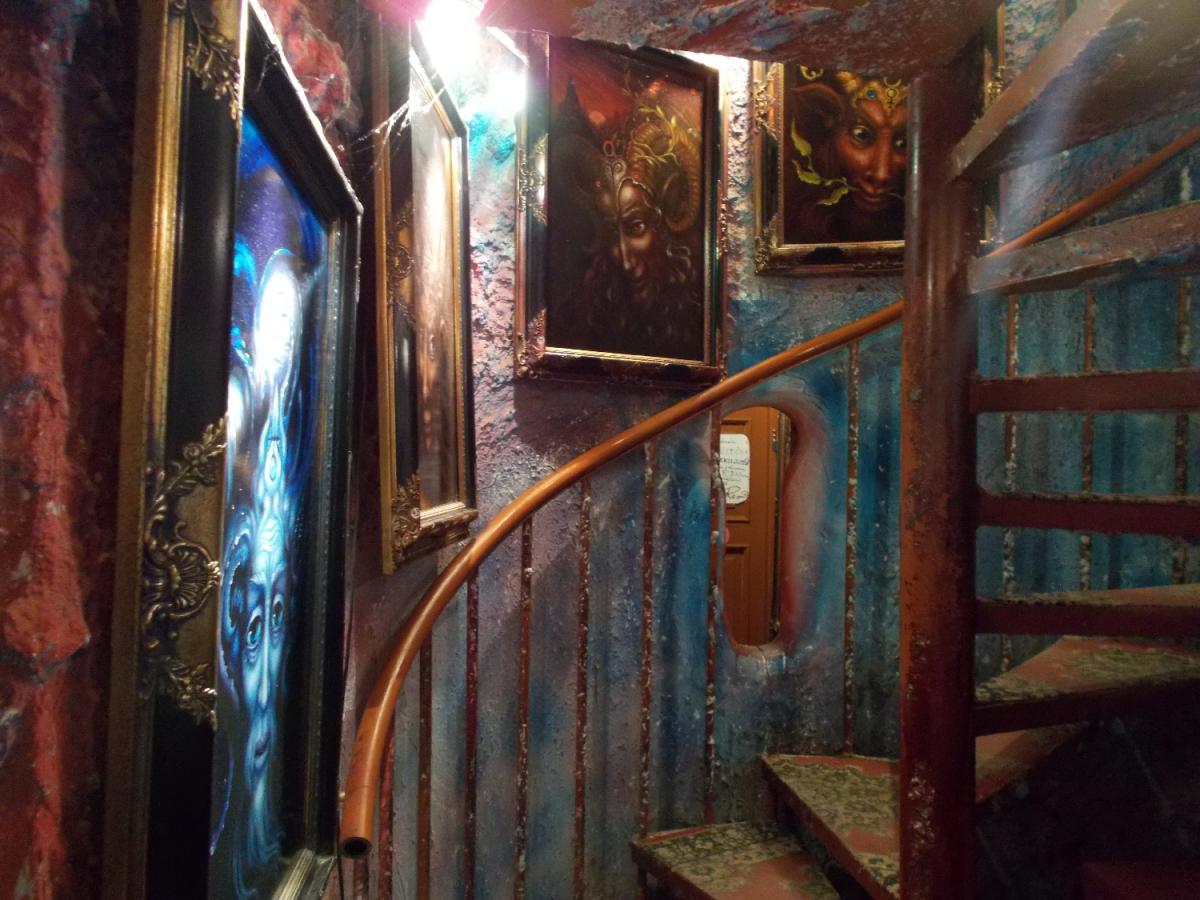
Foto: Konstantin Kountouroyanis
„Ein Tag kann eine Perle sein. Und ein Jahrhundert nichts.“ Gottfried Keller
Und genauso originell wie es der Schöpfer selbst ist, ist auch sein Haus der Magischen Grotte, sind es seine Bilder, ist es die Architektur und die Atmosphäre des Hauses. Das ganze Haus ist über mehrere Etagen von dem Klang keltisch-irischer Musik erfüllt und im Untergeschoss stehen ein Sofa und unberechnete (also kostenlose) Getränke bereit, die den Besucher zum Verweilen einladen. Man sollte und man muss sich Zeit für den Besuch der Galerie nehmen. Und davon gibt es in dem Haus eine Menge. Die Öffnungszeiten sind täglich von 10:00 Uhr – 22:00 Uhr, auch montags. Reon hat sein Haus der Magischen Grotte absichtlich für Leute geschaffen, die raus wollen aus der täglichen Hast, dem Druck der Globalisierung entfliehen. Wenn man in seiner Galerie steht, umgeben von keltischer Musik und den Moment ganz für sich genießt, dann erschließt sich dem Besucher, dass ein einziger Augenblick ein ganzes Universum sein kann. – Tun Sie daher sich und anderen einen Gefallen und schalten Sie noch vor dem Gebäude ihr Handy aus. Ein Klingeln käme dem Versuch eines Liebestöters gleich.
Prag, 12.02.2018
Konstantin John Kowalewski
Artikellink: https://www.prag-aktuell.cz/blog/im-haus-der-magischen-grotte-12022018-2...
Magická Jeskyně (Magische Grotte)
Haltestelle: Nebozízek
(Die Fahrkarten für die Trams/Busse gelten auch für die Standseilbahn).
Anschrift: Petřínské sady 417, Prag
Eintrittspreise siehe: www.reon.cz
Öffnungszeiten: Mo. – So., 10h – 22h
Dauerausstellung!
The House of the "Magical Cavern"
Visiting the Prague Artist Reon Argondian on Petrin Hill
By Konstantin J. Kowalewski
Czechia may have always been the land of a thousand legends and sagas. From its predecessor Čech to Libuše and its prophecy, to the Přemyslids and the fairies and mythical creatures of the Czechoslovakian fairy tale films, Prague and the surrounding areas pass through a network of mystical stories. Gustav Meyrink, the undisputed master of Fantastic Literature, once wrote: "At such times of night I cannot sleep; I cannot wake; in its half dreaming state my mind forms a curious compound of things it has seen, things it has read, things it has heard-streams, each with its own degree of clarity colour, that intermingle, and penetrate my thoughts." This could also be the description of a picture by Reon Argondian, whose paintings are displayed in bright colors over several floors in an inconspicuous house on the Prague Laurenziberg, which is called Petřín in Czech.
Reon Argondian, who was born on July 21, 1948 by the real name of Jan Zahradník in the Prague district of Vyšehrad, was influenced early on his parents who were also artistically creative. His father was an impresario. First, he did a pottery education. After the Prague Spring, he left the country in 1969 as many others before. He followed an invitation from Swiss friends to study art history there. From Switzerland, he went to France where turbulent years as a painter followed and where he created the phantasmagoric world as a "Magical Cave". There he developed amongst other things the pictures of expressive, prophetic strength, as it were Meyrink's description of his protagonist Athanasius Pernath, who read the book of the Buddha Gotama: "A crow flew down to a stone that looked, as it lay, like a lump of fat. Thought the crow, 'Here is a toothsome morsel for my dining'; but finding it to be nothing of the kind, away it flew again. So do we crows, having drawn near to the stone, even so do we, would-be seekers after truth, abandon Gautama the Ascetic so soon as in him we cease to find our pleasure."
From the "The Crow's Mill" to the "House of Phoenix"
In 1988, Reon Argondian opened his first gallery in Sainte-Brigitte, in Brittany, with aptly-named "The Crow's Mill", which was destroyed by a fire in 1991 and replaced in 1992 by "The House of Phoenix". The name of the house indicates unmistakable parallels to Greek mythology. But in his native country, the "Velvet Revolution" of 1989 had meanwhile changed a lot, so he decided to regain his foothold in Prague. For more than a quarter of a century, from 1969 to 1995, Reon has been outside his hometown and country. His first exhibition in the Karolinum was a complete success and so a short time later his art project the "Magic Cave", which was first launched in an old bakery near the Charles Bridge, followed. But the constant change between two galleries, which were more than 1500 kilometers apart, limited his creative power. Reon Argondian decided in 1996, with a heavy heart, to close the "House of the Phoenix" and finally return to Prague.
A Prague genuine on Petřín hill
Since 2005 he lives and works on Laurenziberg, as described above, in his house which also contains a studio and a gallery. Nowadays, when you go to the station Újezd, take the funicular (not tram) and get off at the first stop "Nebozízek". A sign to the "Magical Cavern" or "Magická Jeskyně" shows you the way to the house, which is located about 500 meters away between the forest edge and the well-known park restaurant. The entrance fee, which is between 20 - 70 crowns (children, retirees, adults) is quite far from the high tourist prices in the city center, and can be paid right at the entrance to a young man, whose appearance looks not unlike Reon.
Just like the artist, the man at the cash register is also dressed in a long, heavy coat and wearing a cowboy hat. If you are lucky, you will meet the artist himself, who, with his long beard, reminds one of the slightly eccentric artist from Austria, Friedensreich Hundertwasser (known as well as Stowasser, which means a hundred waters). You can describe Reon as a man who is anything but a person adapted to social conventions, only obliged to his conscience. In one word: A genuine person!
"A day can be a pearl. Neither a century nothing. "
Gottfried Keller (German poet)
And just as genuine as the creator himself is his house of the Magic Cavern. Just like his paintings, the architecture and the atmosphere of the house is mystic. The whole house is over several floors, filled with the sound of Celtic-Irish music, and in the basement there are a sofa and uncalculated (so free for the visitors) drinks ready to invite the visitor to linger. You should and you have to take time to visit the gallery. Time…, there is a lot of that in the house. The opening hours are daily from 10:00 to 22:00, also on Mondays! Reon purposely created his house of the Magic Cavern for people who want to get out of the daily bustle, escaping the pressure of globalization. Standing in his gallery, surrounded by Celtic music and enjoying the moment, opens up to the visitor to the idea that a single moment can be a whole universe. Do yourself and others a favor and switch off your mobile phone in front of the building. A ringtone would be like an attempt of a buzzkill.
Prague, May 08, 2018


